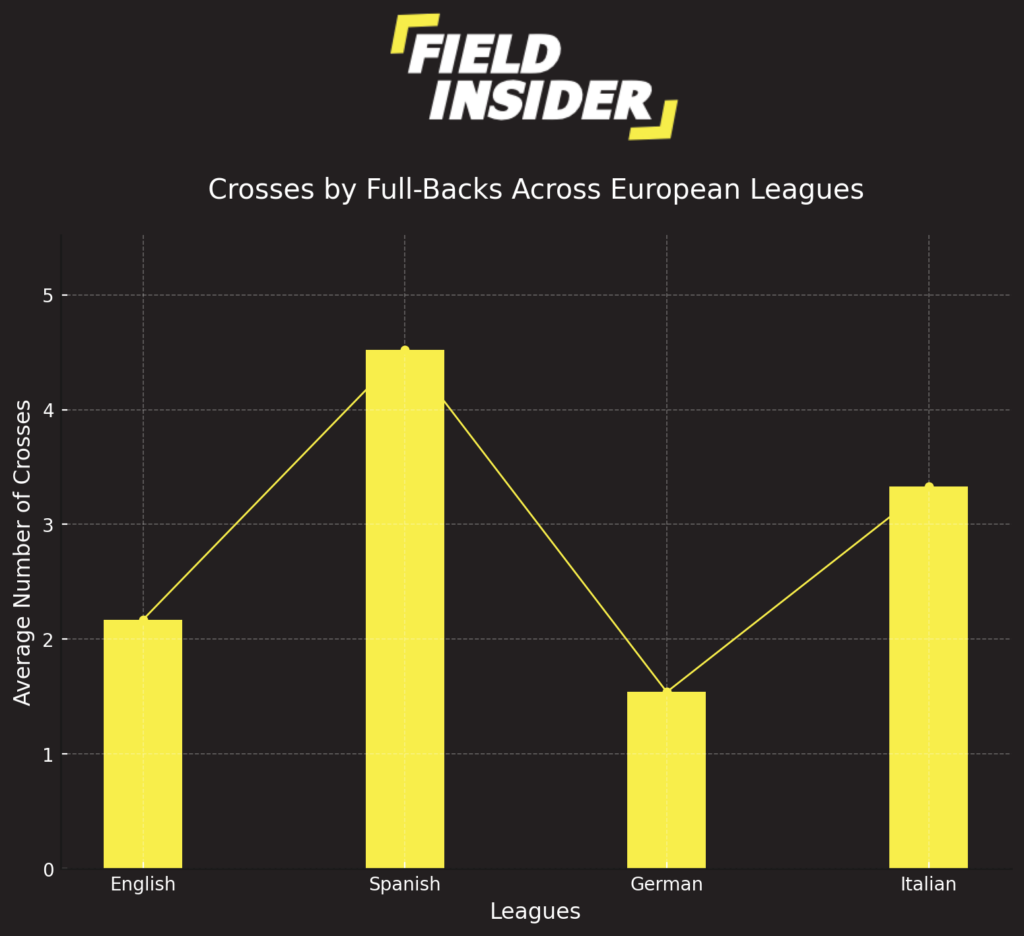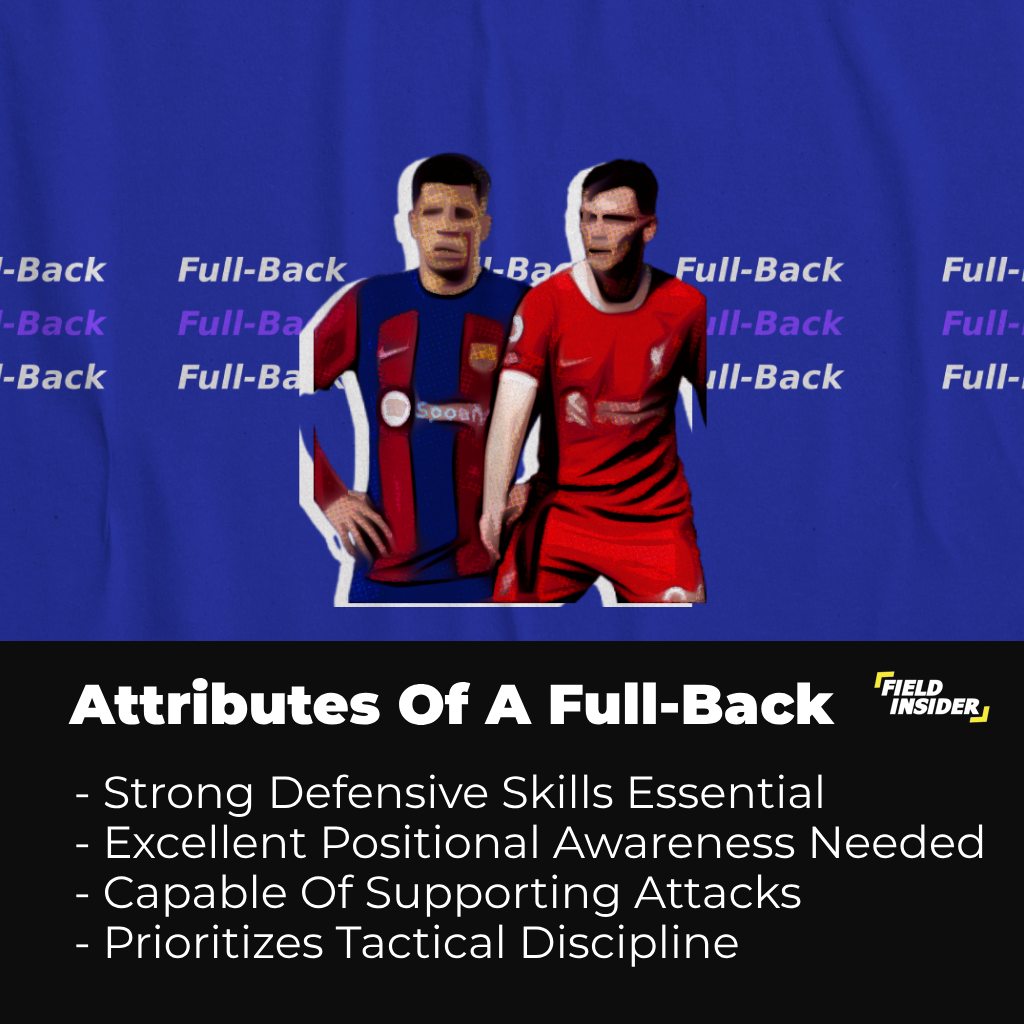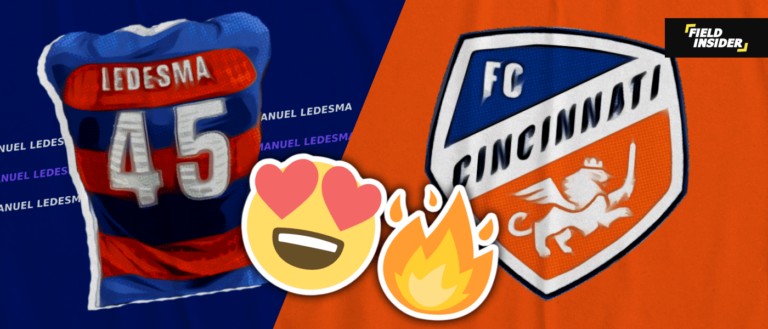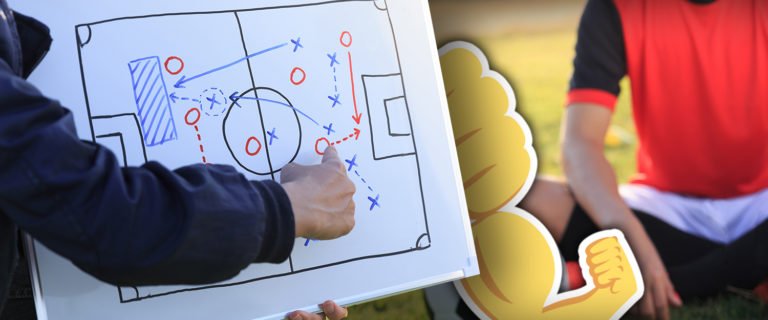Wing-Back vs Full-Back: Same Position?
Soccer, a sport rich in complexity and strategy, features a range of specialized positions that contribute uniquely to the team’s overall dynamics. Among these, the roles of wing-backs and full-backs are often discussed but not always clearly distinguished.
This article aims to demystify these roles, clarifying their responsibilities, tactical implications, and the critical differences between them. Understanding these distinctions provides deeper insights into the strategic choices made by teams and their impact on soccer’s ever-evolving landscape.
Key Takeaways
| Aspect | Wing-Backs | Full-Backs |
|---|---|---|
| Role in Formation | Thrive in systems like 3-4-3 and 5-3-2, offering width and attacking support. | Essential in 4-4-2 or 4-3-3 setups, balancing defense with conservative attacking contributions. |
| Offensive Contributions | Act as primary attackers, focusing on driving forward, providing crosses, and supporting the forward line. | Provide secondary attacking support through overlaps and crosses from deeper positions, with a more conservative approach. |
| Defensive Responsibilities | Must balance attacking impulses with the need to track back and defend wide areas. | Emphasize defensive solidity, focusing on stopping opposition wingers and blocking crosses. |
| Tactical Flexibility | Their effectiveness varies significantly with the team’s tactical setup, requiring players to adapt to both offensive and defensive duties dynamically. | More traditional and static, with a clear emphasis on defensive tasks while maintaining the capability to support attacks. |
| Player Attributes | Require speed, stamina, and excellent crossing ability to fulfill their role effectively. | Demand strong tackling skills, positional awareness, and the ability to maintain defensive discipline. |
Defining the Roles
Wing-Backs

Offensive Responsibilities
Wing-backs are essential in modern soccer tactics, particularly in systems that favor expansive, attacking play. They are expected to provide width, frequently overlapping with midfielders to deliver crosses and participate in forward thrusts.
Their role is critical in formations like the 3-4-3 formation, where their ability to oscillate between defense and attack enhances the team’s dynamic.
Defensive Duties
Despite their offensive leanings, wing-backs must not neglect their defensive responsibilities. They are required to retreat quickly during opposition counter-attacks, covering wide areas and ensuring their flank is not exposed.
This dual role demands exceptional fitness and tactical awareness, characteristics vital for the modern wing-back.
Tactical Flexibility
Wing-backs offer tactical flexibility, adapting their play style to the needs of the match and the strategic direction of their coach. In more defensive setups, they might focus on holding their width and conserving energy for selective attacking runs.
Conversely, in a more attacking mindset, they could spend significant periods in the opposition’s half, as seen in 5-3-2 formations.
Full-Backs
Defensive Focus
The primary role of full-backs is to defend against the attacking threats on the flanks. They are tasked with blocking crosses and halting the advances of opposing wingers, forming a critical part of the defensive line in a 4-4-2 formation or 4-3-3 formation.
Their ability to stay disciplined and maintain positional integrity under pressure is paramount.
Supportive Role in Attack
While traditionally less involved in attacking compared to wing-backs, full-backs still contribute to offensive plays. They provide support by creating overlaps that can confuse the defense and open up spaces for midfielders or wingers.
Their crossing from deeper positions can also be a valuable asset, especially when the team is looking to stretch the opposition’s defense.
Tactical Positioning
Tactical positioning is crucial for full-backs; they must balance their forward movements with the necessity to defend their turf. Their understanding of when to push forward and when to stay back is influenced by the overall team strategy and the flow of the game.
This disciplined approach to both defending and attacking ensures that the team remains balanced and compact.
Key Differences
Offensive Contributions
Wing-Backs as Primary Attackers
Wing-backs are heavily involved in the offensive play of their teams, acting as primary attackers on the flanks. They push forward to exploit spaces, deliver precise crosses, and even participate directly in goal-scoring opportunities.
This role is especially pronounced in formations designed to maximize width and attacking pressure, such as the 5-2-3 formation.
Full-Backs Providing Secondary Support
In contrast, full-backs are more conservative in their offensive contributions. They typically support the attack through overlapping runs that complement the forward or midfield players, rather than leading the charge themselves.
Their involvement is crucial for maintaining possession and building pressure but is secondary to their defensive duties.
Defensive Responsibilities
Wing-Backs Covering Wide Areas
The defensive role of wing-backs extends to covering wide areas of the pitch, ensuring that their aggressive positioning in attack does not leave the team vulnerable at the back.
Their speed allows them to recover their defensive position quickly, a critical requirement in systems like the 3-4-3 formation where they must transition rapidly between attack and defense.
Full-Backs Emphasizing Defensive Solidity
Full-backs, on the other hand, prioritize defensive solidity over offensive exploits. Their primary task is to prevent breaches along the flanks, focusing on stopping opposing wingers and blocking service into the box.
Their tactical positioning within traditional four-defender setups, such as the 4-3-3 formation, is fundamental to maintaining the team’s defensive strength.
Certainly, let’s expand the description of the chart for a more detailed article inclusion.
Crosses by Full-Backs: A Tactical Analysis Across Europe
In the graph derived from the detailed study, “Analysis of Match Performance of Full-backs from Selected European Soccer Leagues,” we see a stark differentiation in the average number of crosses per match by full-backs.

Spanish league defenders top the chart, averaging 4.52 crosses, which might reflect a tactical inclination towards wing play. English league full-backs follow with 2.17 average crosses, showcasing a balanced approach between defense and forward runs.
German league participants register the least with 1.54, possibly indicating a more conservative or central-focused style. Italian full-backs stand out with an average of 3.33 crosses, hinting at a hybrid of defensive rigidity and offensive support.
This visual data not only provides an insightful cross-league comparison but also spotlights the distinct tactical signatures that characterize Europe’s footballing elite.
Tactical Variations
Systems Utilizing Wing-Backs
Advantages and Drawbacks
Wing-backs are instrumental in systems that prioritize width and flexibility, such as the 3-5-2 formation or 5-4-1 formation. The advantage of using wing-backs is their ability to add numbers in both defense and attack, providing a constant wide threat.
However, this requires high stamina and tactical intelligence, as poor execution can lead to vulnerabilities in defense due to their high positioning.
Examples from Top-Level Football
In top-level football, the use of wing-backs has been critical to the success of many teams. For instance, in the 3-4-3 formation, wing-backs contribute significantly to both defensive solidity and offensive width.
This dual role can be seen in teams like Chelsea FC under managers who favor fluid attacking play combined with a solid defensive structure.
Systems Relying on Full-Backs
Tactical Nuances
Full-backs are a cornerstone in more traditional formations such as the 4-4-2 and 4-3-3. Their role requires a nuanced understanding of when to advance and when to hold the line, ensuring the team remains balanced.
The tactical positioning of full-backs is less flexible compared to wing-backs but crucial for forming a resilient backline that can adapt to various offensive threats.
Effectiveness in Different Game Scenarios
The effectiveness of full-backs can vary greatly depending on the game scenario. In defensive situations, they focus on fortifying the flanks and preventing crosses.
Conversely, when their team is on the attack, they must judge the right moments to push forward without compromising their primary defensive role. This balance is crucial, particularly in tightly contested matches where control of the flanks can dictate the tempo and outcome of the game.
Player Attributes and Adaptation
Skill Sets Required for Each Position
Speed and Crossing for Wing-Backs
Wing-backs must possess exceptional speed and endurance, enabling them to manage the demands of covering long stretches of the pitch. Their ability to deliver accurate crosses is also crucial, as it directly contributes to creating scoring opportunities.
These attributes allow them to fulfill their role within the team effectively, especially in formations that leverage wide players for both defense and attack, like the 5-3-2 formation.
Tackling and Positional Awareness for Full-Backs
Full-backs require a robust defensive skill set, including proficient tackling and excellent positional awareness. These skills are vital for managing direct confrontations with attackers and maintaining the integrity of the defensive line.

Their role in more traditional defensive formations, such as the 4-3-3 formation, hinges on their ability to understand and react to the evolving dynamics of the game.
Transitioning Between Positions
Challenges and Adjustments
Transitioning between the wing-back and full-back positions presents significant challenges due to the different demands of each role. Players must adjust their mindset and physical approach to the game, shifting from an attack-oriented to a more balanced or defensively focused role.
This requires not only physical adaptation but also a deep understanding of tactical implications.
Training Drills for Wing-Backs and Full-Backs
| Position | Drill Type | Drill Description |
|---|---|---|
| Wing-Backs | Speed and Stamina Drills | Interval training involving repeated sprints down the pitch, with quick directional changes and recovery jogs. Aims to build endurance for maintaining performance. |
| Wing-Backs | Crossing and Attacking Drills | Drills combining sprinting from deep positions with precision crossing into the box. Focuses on improving chance creation from wide areas under pressure. |
| Full-Backs | Defensive Positioning and Tackling | Tactical drills emphasizing one-on-one defense and group tactics. Focus on proper tackling timing, stance, and strategies for containing attackers. |
| Full-Backs | Support Play and Overlapping Runs | Drills involving coordinated movements with midfielders or wingers, practicing timely overlapping runs and decision-making to balance attack and defense. |
| Both | Integrated Tactical Drills | Drills that simulate real-game scenarios, integrating players into the team’s tactical schemes. Encourages understanding and execution of tactical roles within the team. |
| Both | Adaptation and Flexibility Drills | Drills requiring rapid role transitions between offense and defense, enhancing players’ adaptability and decision-making in varying game conditions. |
Notable Wing-Backs and Full-Backs
Notable Wing-Backs

Trent Alexander-Arnold of Liverpool FC and England has significantly influenced the wing-back position with his exceptional crossing ability and offensive prowess. Known for his intelligent playmaking and incisive passing, Trent exemplifies the modern wing-back who is as vital in attack as in defense.
Achraf Hakimi, currently with Paris Saint-Germain and representing Morocco, is another stellar example of a dynamic wing-back. His blistering speed and agility make him a formidable presence on the flank, capable of making deadly attacking runs as well as performing crucial defensive recoveries.
Alphonso Davies of Bayern Munich and Canada showcases the dual capabilities required of a top-tier wing-back. His remarkable speed allows him to cover large areas of the pitch, aiding in both defensive duties and offensive contributions, making him a key asset in Bayern’s tactical setup.
Notable Full-Backs
Andrew Robertson plays for Liverpool FC and the Scotland national team, serving as a quintessential full-back. His remarkable endurance and capacity to balance defensive responsibilities with consistent attacking support are hallmarks of his playing style.
João Cancelo, who has played for top clubs like Fc Barcelona, Manchester City and Juventus and represents Portugal, blends defensive acumen with technical skill. His versatility allows him to play both as a full-back and further up the pitch, adapting to various tactical demands.
Dani Alves, a Brazilian legend, has had stints with Barcelona, Juventus, and PSG among other clubs. Known for his extraordinary career longevity and technical skills, Alves has been a defining full-back in world soccer. His offensive flair combined with robust defensive tactics has set a high standard for what full-backs can contribute to both ends of the pitch.
These players exemplify the evolution and diversity of the wing-back and full-back roles in modern soccer, each bringing unique attributes that enhance their teams’ tactical flexibility and effectiveness.
Conclusion
Understanding the distinctions between wing-backs and full-backs is crucial for appreciating the tactical depth of soccer. These roles highlight the sport’s complexity and the strategic nuances that can influence the outcome of a match.
As the game evolves, so too do the interpretations and implementations of these positions, underscoring the endless strategic possibilities within soccer. This insight enhances the understanding of coaches and players aiming to optimize their performance within these pivotal positions.








